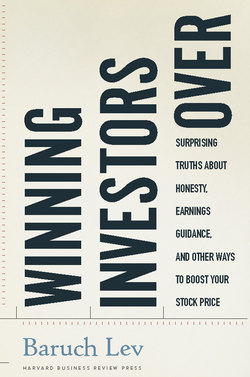Читать книгу Winning Investors Over - Baruch Lev - Страница 13
На сайте Литреса книга снята с продажи.
A Brief but Important Detour on Value Versus Glamour Stocks
ОглавлениеThe sharp investor reaction to an earnings miss of the erstwhile growth company I discussed earlier is related to a major puzzle in capital markets: the consistent, yet counterintuitive superior performance of “value stocks” relative to their “glamour” (growth) counterparts. Drawing attention to the different performance of value and glamour stocks is often attributed to Benjamin Graham, a successful money manager and Columbia University finance professor from 1928 to 1957, whose reputation has resurfaced in recent years by the claim that the legendary investor Warren Buffett developed his finance acumen in Graham’s class. Graham defined value and glamour by relating stock prices to various financial indicators, such as earnings, book value, or cash flows. Glamour stocks have relatively high valuations—high market-to-book (M/B) or price-to-earnings (P/E) ratios—while value stocks are characterized by low valuations.14
It isn’t surprising, of course, that investors favor certain stocks, while others are in the doghouse. If investors expect company A to grow faster than B, they will bid up the shares of the former, resulting in a higher valuation ratio (P/E or M/B) for A than B. However, and this is the basic tenet of efficient (rational) capital markets—one of the fundamental concepts of modern finance theory—if investors properly price securities, taking into account all available information about growth and risk, then the future risk-adjusted returns on the stocks of companies A and B (and, in general, the returns on high- and low-growth stocks) should be virtually identical, despite their current different valuations.15 The different growth expectations are fully reflected in current prices. Stated differently, in efficient markets, one cannot profit from widely known information—in this case, the higher M/B or P/E ratios of company A relative to B—after the fact.16 But here comes the value–glamour puzzle: during most of the post-World War II period, investment in value stocks—out-of-favor equities with low market valuation relative to fundamentals—yielded higher returns than glamour stocks, which investors favored.17 During the period from 1990 to 2008, value stocks yielded, on average, 11.5 percent annually, while glamour stocks returned 9.5 percent only.18 Josef Lakonishok and colleagues documented in 1994 that from 1968 to 1989, stocks with low M/B (value stocks) outperformed high M/B (glamour stocks) on average by 6.3 percent in the year following the valuation and founded a successful fund operation on this principle.19
How can the lowly value stocks consistently outperform their glamour counterparts? The traditional explanation is: compensation for risk. When the market is in positive territory, risky investments yield higher returns than do lower-risk securities, and the higher return on value stocks just reflected their higher risk than growth stocks. The problem with this explanation is that the documented value–glamour return differential is already risk-adjusted, accounting for known risk factors, such as beta (market risk), size, and the market-to-book ratio. Alternatively, the behavioral explanation to the value-growth conundrum rests on investors’ excessive optimism regarding growth stocks. They systematically overvalue the stocks of glamour companies, believing that their past sizzling record of sales and earnings growth will persist into the distant future and undervalue the prospects of the lagging value stocks.20 Thus, for example, the impressive sales and earnings growth rates of the likes of Microsoft, Dell, Vodafone, and Walmart in the 1990s led many investors to believe that these glamour companies would continue to grow briskly well into the twenty-first century, according them high valuation multiples (M/B and P/E ratios). However, as I noted in the introduction, corporate growth is ephemeral, and sooner or later the highfliers stall, inevitably leading to investor disappointment and stock price declines. The reversal of investors’ excessive optimism about glamour stocks and the undue pessimism regarding many value shares explain nicely the value–glamour return differential.
What does all this have to do with missing the earnings consensus? A lot, in fact. Skinner and Sloan document that much of the superior performance of value versus glamour stocks is due to consensus misses of the glamour highfliers when their earnings disappoint investors.21 Thus, the serious retribution to an earnings disappointment of a growth company is largely a correction of investors’ excessive, erstwhile optimism.
